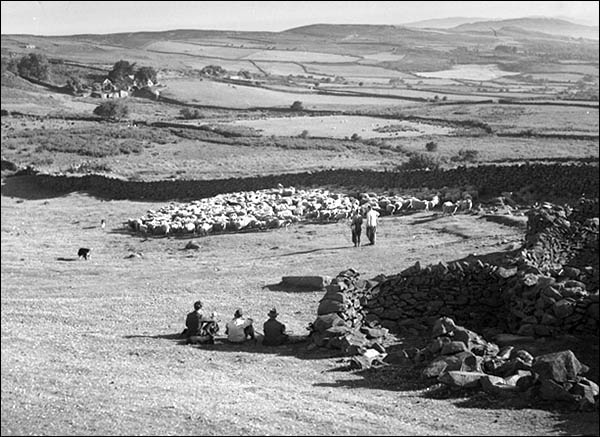Buarth Llangelynnin sheepfold
This multi-cell sheepfold is one of many in the Carneddau area of Eryri (Snowdonia) where sheep from the mountain slopes are sorted several times each year.
It’s 333 metres above sea level and is named after the nearby Llangelynnin church. Buarth is the most common Welsh name for sheepfold in the Carneddau (the alternative corlan is more widespread in Wales). Part of Buarth Llangelynnin is visible on the right in the 1960s photo by Walter Harris, courtesy of Conwy Archive Service.
 A large proportion of the Carneddau is unenclosed common grazing land, where sheep from different farms mix together. Farmers work collectively to gather all of the sheep in July for shearing, September for separating lambs, and October/November for bringing the sheep to lower ground for the winter. In this respect the sheepfolds are communal structures.
A large proportion of the Carneddau is unenclosed common grazing land, where sheep from different farms mix together. Farmers work collectively to gather all of the sheep in July for shearing, September for separating lambs, and October/November for bringing the sheep to lower ground for the winter. In this respect the sheepfolds are communal structures.
Buarth Llangelynnin has 10 cells, including a collection cell. At each gathering, farmers and sheepdogs usher the sheep into the collection cell. Farmers use the paint marks on the animals’ backs to identify the sheep for sorting, but if in doubt they can check the clustnodau (cuts in the ears unique to each farm). The sheep are directed through creeps – holes in the internal walls – to the smaller cell set aside for each farm. Stray sheep belonging to none of the local farmers are repatriated by the chief shepherd, or setiwr. The Welsh name derives from the English escheater.
The oldest Carneddau sheepfolds date from the 18th century, when large estates and wealthy individuals began to enclose the common land. Sheep replaced cattle as the main grazing animals on the Carneddau as they were more profitable, especially when demand for sheep’s wool and meat increased during the Napoleonic wars 1800-1815.
Drovers probably made use of Buarth Llangelynnin, to keep sheep and other livestock safe while they slept overnight near the church. They would take animals along the lane which passes the churchyard and descends towards Rowen, destined for markets in central and south-east England.
With thanks to Nigel Beidas of Cofnodi Corlannau
Grid reference: SH748736 View Location Map
Website of Cofnodi Corlannau – details and photos of the Carneddau sheepfolds
Website of Conwy Archive Service

